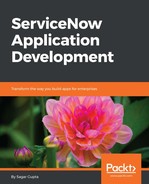Like any other database-based application, information in ServiceNow instances is stored in structured and related tables, which consist of columns and rows of records. Tables can be related to each other in the following ways:
- Extensions: A table in ServiceNow may extend an existing table (parent class), thereby ensuring that all of the fields of the parent class are included as part of the child table. For example, the Incident table extends the Task table, and thus the Incident table has all of the fields that are available in the Task table.
- One to many: A table can consist of a field that refers to a record on another table. For example, the assigned to (assigned_to) field in the Incident record might contain a reference to a record in the users (sys_users) table. The Reference, Glide List, and Document ID field types can be added to create a one-to-many relation between two tables.
- Many to many: Two tables can have a bidirectional relationship when they both refer to a record stored in each another.
- Database views: This is a virtual relationship between two or more tables that can be used to generate complex reports.
In ServiceNow, a table that extends another table is referred to as a child class, and the table it extends is referred to as a parent class. Another table can further extend a child class if it is marked as extensible. In such a scenario, it is a table that is both a child and parent, as it extends and is also an extension of a table. A parent class that is not an extension of another table is called a base class.
